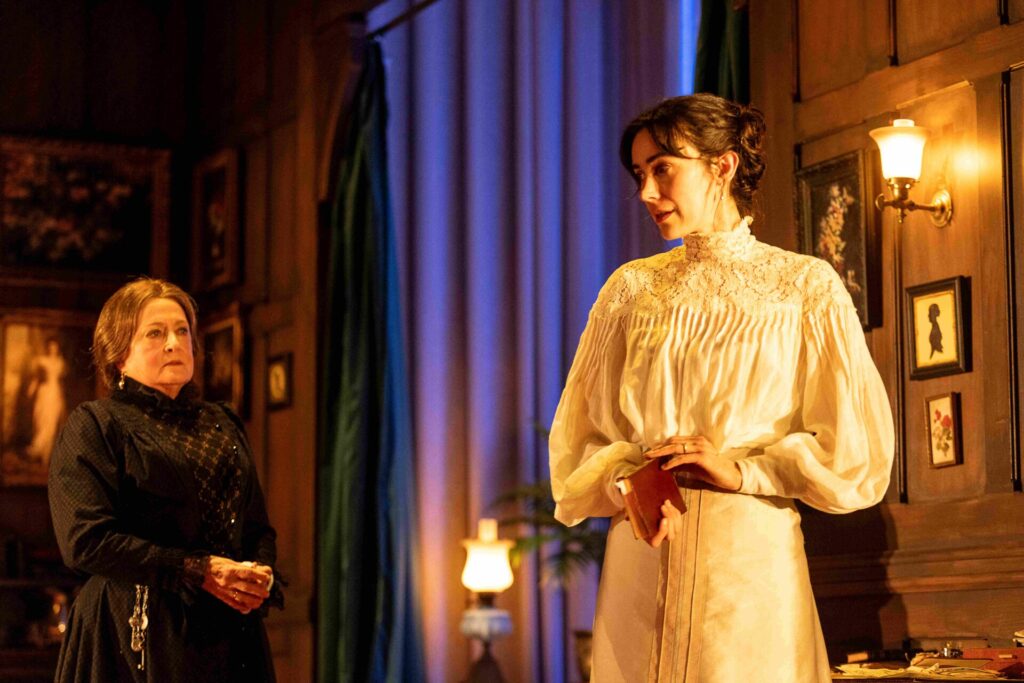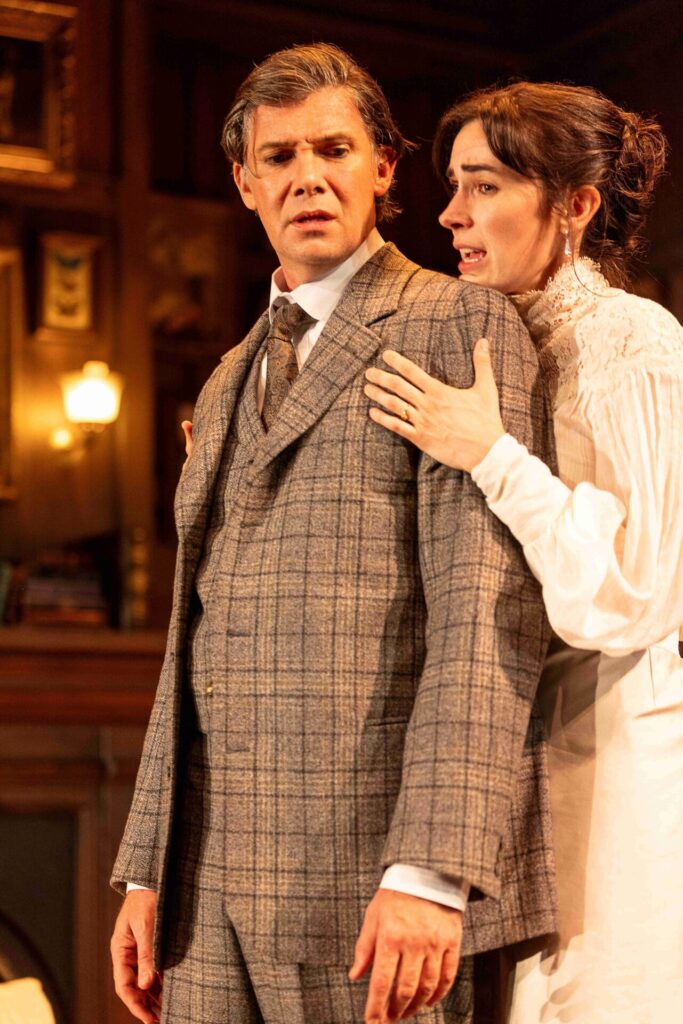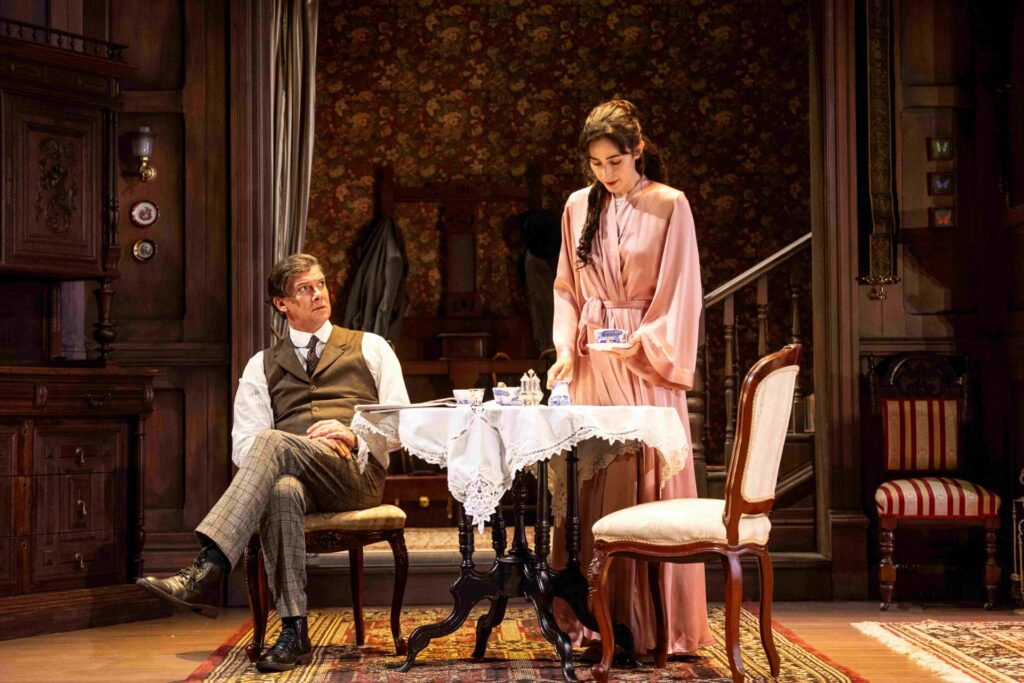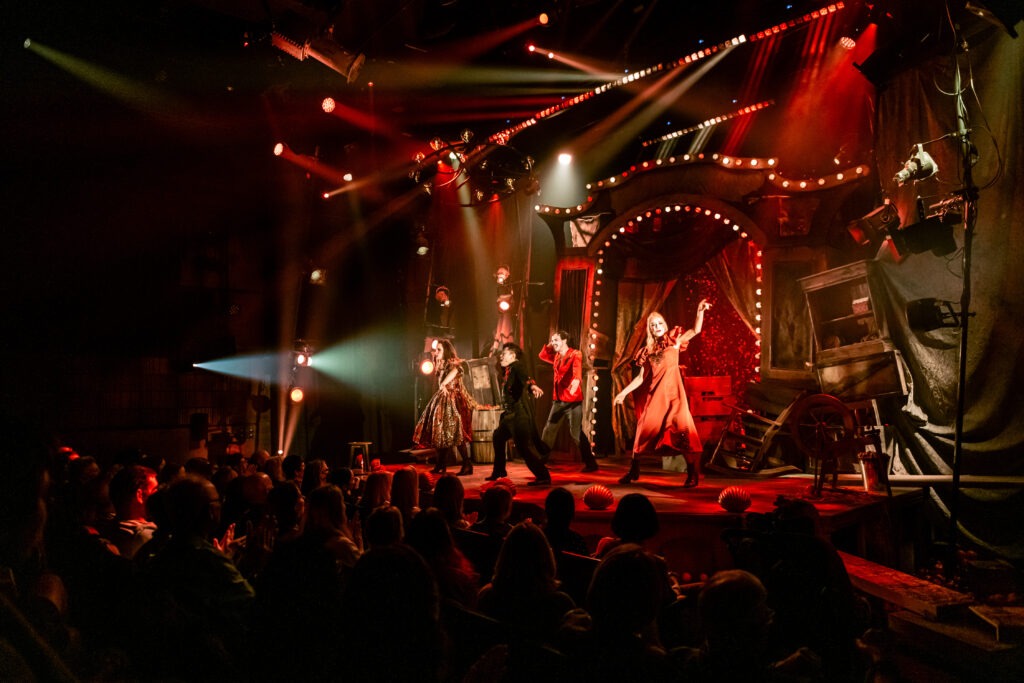
‘Gaslight’ // Queensland Theatre, Rodney Rigby, Marriner Group and TEG
‘Gaslight’ was manipulative.
Queensland Theatre’s psychological thriller, ‘Gaslight’, took to the Playhouse Theatre stage at Queensland Performing Arts Centre (QPAC) with one main intention: to manipulate its audiences in a play that blurs the lines between perception and reality.
To deep dive into the synopsis of this show will mean some key secrets will be given away, but in a nutshell, ‘Gaslight’ centres around Bella Manningham (played by Geraldine Hakewill), a young woman who begins to doubt her sanity as she notices strange occurrences within her home, such as weird noises and the dimming of gas lights. As she navigates these events, a tale of deception and psychological manipulation starts to unfold. The narrative, which is set against a Victorian Gothic backdrop, explores the concept of “gaslighting,” where Bella must determine the reality of her situation and whether she can muster the strength to confront the truth and save herself.
The term “gaslight”, coined by the 1938 British play ‘Gas Light’ by Patrick Hamilton from which this new play is adapted from, articulates the art of manipulation. That is, to “gaslight’ someone is to manipulate them, or even a group of people, to question their own memories, reality or perceptions. Recently, the term has surged in popularity to describe the toxic behaviour where someone is exploited by someone else, usually in relationships where there is a power imbalance. While the literal meaning of “gaslight” refers to lighting that is provided by gaseous fuels before the use of electric lights, this original definition flickers dimly in modern Google searches. However, the definition of actual gas lights does still have some significance in this production.
Queensland Theatre’s marketing for the production then “gaslights” audiences into thinking the production was set in the 2000s, when in actual fact it was set in 1901. The hero imagery used in the marketing campaign showcases a woman lying in white sheets against modern grey and beige finishes. The words madness and manipulation are often associated with this advertising, despite the woman’s ‘lax slumber in the main imagery. As such, it’s then a surprise to watch the production that Johnna Wright and Patty Jamieson have newly adapted, of Hamilton’s 1938 domestic thriller, set in the “latter part of the nineteenth century”. The marketing and production when compared to one another lacks synergy, and the hero image does nothing to build interest. However, if the approach had been of a whodunnit mystery, and played on those words of ‘madness’ and ‘manipulation’, a bit like the Agatha Christie ‘Mousetrap’, maybe then this would have told audiences exactly what they were in store for.
The surprises in the text are then a challenge, as anyone with a vague understanding of the term “gaslighting” will pick one of the main twists early on. Wright and Jamieson’s new adaptation does well to bring a classic out of the shadows, however, some big reveals are predictable, probably more to do with our modern understanding of things and the fact the term wasn’t as well-known in the 1930s.
Scenic and costume design by Renee Mulder was incredibly detailed and extremely extravagant. The play was set in a living room that revelled in a sense of grandeur. A small dining area, chairs by a fireplace, sideboard and a desk filled the space, with two adjoining rooms at the back and side; an entryway and grand staircase upstage, and a bay window stage left. The set was adorned with period-appropriate furnishings, including a table covered with a lace tablecloth, gas lamps affixed to the wall and framed painted artworks, all of which contributed to the set’s atmosphere. The costumes also added to the social dynamics of the characters, with the upper class styled in suits and immaculately dressed, while the ‘help’ wore matronly uniformed attire. A ‘wow’ moment came from Bella Manningham’s opening gown, which really was picture-perfect.
Music composition and sound design by Paul Charlier underscored the suspense and ambience within key moments of the play. Noises like the roar of a thunderstorm created snap scares and the innovation of isolating speakers for each gas lamp ensured a rhythmic order to the piece. The soundscape helped drive changes in scenes as well, and break moments of tension. Equally essential to the play’s visual elements was Paul Jackson’s lighting design. The fluctuating intensities of the gas lights and the changing hues semiotically cued the transitions from night to day. Characters moved through shadows, which created an eeriness in the large ghostlike manor. Jackson cleverly used lighting to pull focus to certain objects and guide the mysterious narrative.
Director, Lee Lewis ensured characters moved around the entire set, and added to the text’s eeriness with clever scene transitions. That is, characters would exit one way, and quickly enter the set on the other side, making it feel like they were ships in the night moving throughout a very big house. These trap door-styled entrances and exits aided the mystery of ‘Gaslight’. That being said, it was strange when, in a pivotal moment of the show, Kate Fitzpatrick as Elizabeth walked the length of the stage around to the main commotion, rather than appearing in one of these quick entrances. If Fitzpatrick had appeared quickly, we wouldn’t have lost the pace in a key scene, which made the reveal a little lack-lustre.
Additionally, while QPAC’s Playhouse Theatre presents many challenges for directors, due to its equally intimate and distant design, the action felt as if it was directed by a stationary director who hadn’t moved around the space to view the show from different angles. From the audience’s right (stage left), there was restricted viewing, which meant any scenes that played out in the bay window, due to the sharp angular nature of the set, were missed. Due to the fly-on-the-wall nature of the production, the impact of the play may have also been lost towards the back of the stalls or in the dress circle, as it would have meant audiences would have missed some delicate intricacies in the blocking.
A standout performance came from Geraldine Hakewill as Bella Manningham. Hakewill was incredibly compelling to watch, using her whole body to display grief, madness, resolution and betrayal. Even the way Hakewill physically moved, like shaking to read a letter, was outstanding and Hakewill drove the action of the play.
Toby Schmitz as Jack was pompous and manipulating. The audience was positioned to dislike him immediately, so the fact he got on the nerves of some (shown by audible frustrations) was commendable.
Both Kate Fitzpatrick and Courtney Cavallaro provided comedy breaks in the tension. Fitzpatrick, as Elizabeth, was stern and measured, reflecting the rigid and subdued characteristics of a servant in a well-ordered Victorian household, although the delivery of lines over time felt repetitious. Contrasting the household dynamics, Cavallaro was even more comedic entering scenes with energy and vigour. As Nancy, Cavallaro was fun and youthful, especially in her portrayal of the kind of girl that a mistress should not have as a housemaid.
Queensland Theatre’s ‘Gaslight’ was like an ex-boyfriend – you thought you knew what to expect, but there were some surprises left in store. The production flickered to life with a set that could double as a Victorian time capsule, and design elements that created mystery and intrigue. While the play’s attempt to pull the wool over our modern eyes wasn’t as effective as it could have been, it is worth a watch if true crime and mystery are your cup of tea.
‘Gaslight’ performs at QPAC until Sunday, 3 March 2024. For more information and to book tickets before the gas runs out, visit QPAC’s website.
Photography by Brett Boardman








